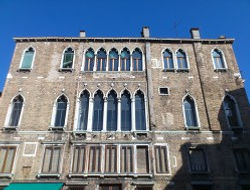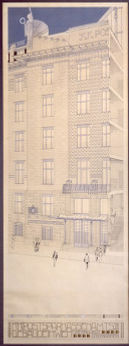Chris Rogers | Writer on architecture and visual culture
The third generation of his family to head the practice founded by his grandfather in 1904, Michael’s own 50-year career includes teaching at and presidency of the Architectural Association and a pivotal role in the fight for its independence, friendship with major British architects of the period including Cedric Price, Jim Stirling and Roy Landau and contact with international figures such as Louis Kahn and Jean Prouvé.
Michael’s architecture is one of technical innovation, economy and sensitivity for local conditions. Change is coded in from conception. Work across the world, including entries for the Pompidou and Tête Défense competitions, culminated in the radical and prescient Burne House in London, the first commercial building in Britain with a fully interchangeable modular cladding system, years before similar work by Rogers, Grimshaw and Foster. A strong belief in meaningful engagement with users rounds out this fascinating practitioner who moved in a critical phase of post-war British architecture and continues to practise today.
This is a rare opportunity to hear an architect experience, recall and review his own work with candour and humour.
- Black Dog Publishing
- August 2010
- Softback, 192 pages
- 300 images, 28cm x 23cm
- ISBN 978 1 906155 735
In bookshops The Power of Process – the Architecture of Michael Pearson
"Congratulations on such a handsome and interesting book... Pearson has been a rather under-rated and slightly over-looked figure... your book does a very great deal to redress his position"
John Robertson Director, John Robertson Associates
“Splendid work… I have really enjoyed it… I hope it will be a great success”
Andrew Murdoch Director, Aukett Fitzroy Robinson
“A great achievement. One forgets how much of today’s architecture he heralded… a wonderfully accessible work”
Tony Miller Partner, Trehearne Architects
Research for my next book is underway. It will celebrate an overlooked, indeed almost forgotten, period in the development of London’s architecture – the post-war years, from the first shoots of economic recovery, through the boom years, and ending when the oil crisis hit, building stopped and commercial architecture pupated before emerging, damp and gleaming with new colour and uncertain direction, in the post-modern 1980s.
These buildings represent a lost age, a British architecture that combined traditional materials and craftsmanship in a friendly, softer Modernism for a City that was moving from bowlers and brollies to E-Types and the Barbican. It provided great American-style blocks in stone and glass set amongst Roman remains, a perfect world for the new meritocrats.
But the pressure cooker that is the Square Mile has seen demolition of this architecture at a startling, almost careless, pace since the 1990s taking examples modest and grand, mediocre and outstanding. It is a campaign of destruction rivalling that which gave rise to these buildings in the first place.
In its architecture, that lost age showed a vitality, originality and quality that has never been matched, creating a world that has now vanished forever.
In preparation Lost world: The vanishing post-war architecture of the City of London
“Overjoyed... we had no idea of his talents, achievements, or width and breadth of his periods and styles of buildings. Just amazing… a treasure forever”
Andi Ewen for whose husband Michael designed a new studio

For some, Venice is an idea. For Byron, it was a frequent home and place of many liaisons dangereuse. For artists, from Canaletto, Tiepolo and Ruskin through Wagner, Whistler and Turner to James, Browning and Hemingway, it was a place of pilgrimage and inspiration. For Napoleon, victorious, it was...
Time is the essence of television. The fractional pulse of electrons, the flight of photons, the persistence of vision that moves the image from screen to eye; and the compression of events and space that is the cornerstone of the medium’s power. In documentaries...
The sports car; image, style and speed within a single form. A feeling of beauty and of elegance. The car is a machine but more than a machine; it transcends mere mechanics and becomes sculpture, totem, icon. Industrial design meeting art. The post...
The museum, that grand building containing art or artefacts standing proud in the town square, has become the signifier of cultural awareness for a nation. Long-established institutions have enlarged their premises every twenty years or so, newcomers have arrived, and even the smallest or least likely of cities has striven to open galleries...

Film Skyfall: Analysis and architecture
Television TV times
Design Dream machines: The sports car
Art Museums without walls
"Burne House... and... Michael Pearson’s career bear comparison with other projects and other architects of the period… this book throws light on... significant achievements"
22 Dec 2013 9 Dec 2013 30 Nov 2013
Raiders of lost television The Great Martian Hold.
programmes celebrate a War is recalled a On.
very British enterprise century on Tight.
Patrick Duerden Associate, Donald Insall Associates


Practice Ben Johnson: Confrontations with reality
An exclusive conversation between Chris Rogers and practitioners showing how they work when at their work. The subject of the first of these extended, intimate portraits is artist Ben Johnson. Ben discusses how and why he works, what shapes his art and his love of craft in the context of recent paintings
In partnership For Art Quarterly, the Art Fund's magazine, The Interpretation Of A City
As a new exhibition of portraits from fin-de-siècle Vienna opens at the National Gallery in London, Chris Rogers examines the unparalleled changes in culture, science and thinking that swept that city at the turn of the twentieth century in the new edition of the Art Fund's magazine
The modern world arrived in 1900. In Britain the Daily Express is published for the first time. In Germany the first Zeppelin takes to the skies. In Paris visitors to the Exposition Universelle sway on the first Metro train.
In Vienna especially, 1900 saw action, reaction, ambition and innovation in a dynamic metropolis at the heart of the Austro-Hungarian Empire. Sigmund Freud’s theory of psychoanalysis was published as The Interpretation of Dreams. Arthur Schnitzler committed to print the interlinked relationships of successive pairs of lovers in his play Der Reigen, better known by its French title, La Ronde. Gustav Mahler completed his fourth symphony whilst continuing to direct the Vienna court opera. Otto Wagner was immersed in taming the city’s very waters with elegant new locks, weirs and quays, having seen the Emperor open the new urban railway that he had spent six years designing.
Across this site Thirty years after its release, Fragments of a hologram rose: Re-seeing Blade Runner



In partnership For Excuses and Half Truths, analysis of Japanese anime in States of Mind: Patlabor on film
Chris Rogers writes in depth for Excuses and Half Truths on the groundbreaking Japanese Patlabor feature films.
Produced from the late 1980s, the three films combine outstanding science fiction action and drama with incisive cultural comment on Japan's past, present and future, touching on world war 2, the American occupation, Imperialism, the individual versus the group and much more.
The films also set new standards in cel animation that allowed the craft to approach live action in ambition and impact.

New



31 Dec 2013
...looking back at my cultural highlights of this year





Click for web-exclusive additional content complementing the published edition, including images and text, and coverage of the launch at the Architectural Association in November 2010
Architecture Venice: The gilded cage
James Bond’s obituary has been written many times, on screen and off, but he triumphantly returns in Skyfall. The themes of the film are discussed in a piece that analyses its power, whilst in another article the architectural world of illusion created by the film-makers is uncovered.
Five pieces with unique insights, new connections and carefully sourced imagery each illuminate a portion of the infinite whole: Film uncovers traces that remain as memories of early scripts and Dick's novel; Television discloses the secrets of the haunting Esper sequence; Architecture examines the architecture of 2019 Los Angeles; Art walks its streets through the paintings of visual futurist Syd Mead; Design inspects the tools of the RepDetect trade
The new edition of the Twentieth Century Society’s magazine (issue 1/2013) contains an article by me on London Wall, the post-war dreamscape created by City of London planners that now lies forlorn and almost abandoned.
Its direct inspiration, mentioned in the piece, is illustrated and described in more detail on this site as a preview of research for the new book: Stockholm’s Hötorgscity, pictured right, is a remarkable survivor and makes for a fascinating comparison with its Square Mile sister.
Further such previews will follow.